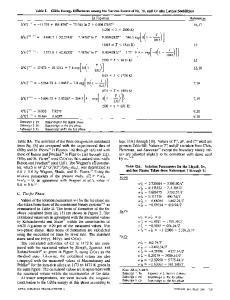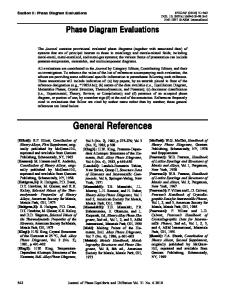Calculation of the titanium-aluminum phase diagram
- PDF / 493,669 Bytes
- 5 Pages / 613 x 788.28 pts Page_size
- 67 Downloads / 429 Views
I.
INTRODUCTION
A thermodynamic calculation of the Ti-A1 system will be reported; a calculation of this system is needed in order to interpret the results of rapid solidification experiments and predict the relative stabilities of metastable phases. For interpreting rapid solidification experiments, To curves (the locus of compositions and temperatures where two phases have equal Gibbs energies*) and metastable extensions of * In this paper one of the phases is always assumed to be the liquid.
the phase boundaries are usually examined for phases far from their stable equilibrium ranges of stability. These metastable extensions may be unreliable if Gibbs energies are represented by polynomial expansions determined from equilibrium data over a limited composition and temperature range. This is particularly true of sublattice models for Gibbs energies of ordered phases, which are treated as expansions about the fully ordered state at stoichiometry. It is thus desirable to combine the strengths of physically based order-disorder calculations with the strength of parametric approaches to modeling Gibbs energies. Nonlinear least squares optimization of empirical Gibbs energy functions is the most widely used technique for the analysis of alloy phase equilibria because it provides an efficient and universally applicable method for obtaining the best compromise among all the available experimental data. However, this technique does not take into account structural relationships among phases or offer predictions about the order-disorder transformations that may occur, stably or metastably. For example, a Gibbs energy for a disordered phase of wide solubility may be consistent with ordering at low temperature, but such implications may be overlooked when polynomial expansions or other empirical functions are used to calculate the phase diagram and thermodynamic properties. Moreover, extrapolations of purely empirical functions away from the stable equilibrium range are of unknown reliability and physical models are necessary as guides to the interpretation of calculated metastable equilibria. The cluster variation method (CVM) provides a one- or two-parameter calculation of coherent equilibrium between a disordered phase and simple ordered structures based on JOANNE L. MURRAY, Staff Scientist, is at Aluminum Company of America, Alcoa Technical Center, Alcoa Center, PA 15069. Manuscript submitted March 17, 1987. METALLURGICAL TRANSACTIONS A
the same lattice. In CVM calculations, attention has been paid primarily to the order-disorder equilibria, and not so much to the consistency of the Gibbs energies with those of the other structurally dissimilar phases of the systems. Sigli and Sanchez ~ have shown by a strikingly simple and successful calculation of A1-Li that such calculations are feasible. In the present calculations empirical Gibbs energy models were recast in terms of the Bragg-Williams (BW) approximation for order-disorder transitions; Gibbs energies were constructed that give a reasonably self-consistent picture
Data Loading...











